Glass A - Z / Glass A - B
Glass A - B
A - Egyptian glass
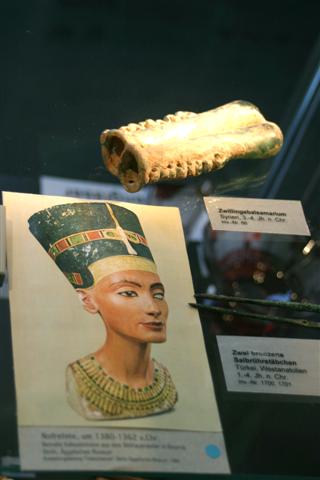
A - Egyptian glassmakers have been producing glass, including glass beads, amulet pendants and small vessels for precious ointments and oils, since around 1500 B.C. They probably first used imported raw glass in the form of chunks or coloured glass ingots from the Near East (including Mesopotamia). The earliest discovered glass workshops in Egypt are in the area of the palace of Amenophis III. (c. 1388-1351 BC) and in el-Amarna.
The production technique - moulding around a core - was elaborate and difficult. Egyptian glass was therefore considered a distinctly luxury glass, produced for the needs of the court or as valuable gifts in the service of diplomacy.
A - Alabastron, Aryballos, Amphoriskos
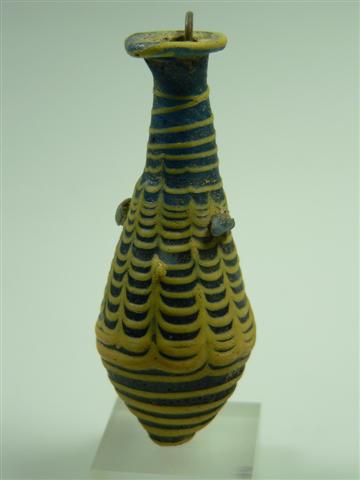
A like Alabastron, Aryballos, Amphoriskos and other luxury anointing vessels made in the core-formed technique, which can be seen in the Glass Museum, date from the 6th to 1st century BC - the second heyday of Egyptian glass art.
In contrast to the vessels produced in Mesopotamia and Egypt in the 2nd millennium BC, where the body was sintered (rolled in glass powder) over a core, late core vessels have both body and decoration wrapped around the core. This allowed for faster production and greater productivity.
The technique spread from the eastern Mediterranean area, with Rhodes as its centre, to Italy later on. In contrast to the late core vessels, the surface of the early Egyptian core vessels was much smoother and shinier and the glass had fewer air bubbles.
A - Antique glass
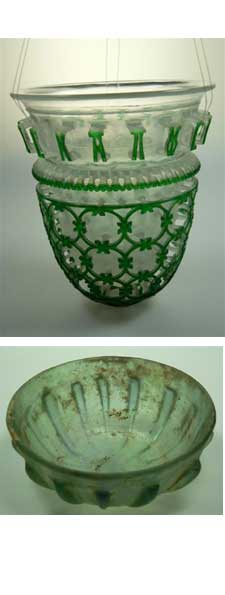
A for Ancient Glass stands for Roman glass art (ca. 2nd to 6th century). Due to their net-like, openwork decoration of extreme fragility, diatrette glasses (from the Greek diatreta = cup with openwork) are among the highlights of Roman glass production and finishing art in the 1st to 4th century A.D. Roman glass art owes its high status and enormous upswing to two revolutionary advances:
- the invention of the glassmaker's pipe (1st century B.C.) and
- the discovery of the artificial decolourisation of glass.
The glassmaker's pipe enabled
- the serial production of simple hollow glass, e.g. bottles, ointment vessels or jugs, and
- the development from luxury glass to utility glass
According to Rosemarie Lierke (in: Die nicht-geblasenen antiken Glasgefäße. Offenbach 2009), ribbed bowls like this one from the 1st century BC/end of the 1st century AD were the successful model of ancient glass production due to their simple production. In competition with blown glass, a ribbed bowl was created in one to two minutes on a wheel by lowering a hot glass cake over a core mould and working it further with tools.
A - Alembic, medicinal jars, pharmacy jars
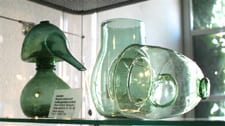
A for alembic, medicinal jars, apothecary jars and the advantages of glass for medicinal and chemical purposes were already recognised by the ancient alchemists. Glass was ideal for alchemical processes and for storing liquid and solid substances.
A - Ampoules
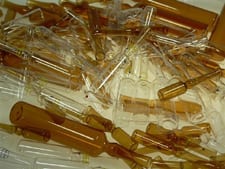
A for ampoules for pharmaceutical, medical and industrial purposes are classified in the container and packaging glass sector according to their use. Ampoules belong to the products of the Wertheim special glass industry.
Further glass under A:
Clarification bottle, hydrometer, car mirror
B - Paperweight
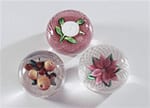
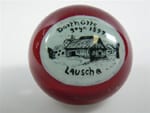
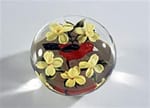
B for paperweights (English paperweights, French presse-papiers) "Classics" (1840-60 and 1900)Popular motifs "Millefioris" ("Thousand flower glasses")Produced e.g. in Silesia/Bohemia (Josephinenhütte, Haida/Novy Bor), Italy/Venice,
France (Baccarat, Saint-Louis, Clichy)
Folk art "classics" (1860/70-1930/45)Most common motifs: "trumpet flowers", "five-blow paperweights", flowers and animals. Made during work breaks, e.g. in Gablonz/Bohemia and Lauscha/Thuringia.
Collector's items (1950 to today)produced in limited series in our own studio kiln or in large glass factories all over the world.
"Scarlet Tanager", 1986, by Rick Ayotte, USA
B - Peasant silver
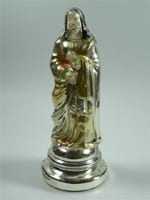
B for Bauernsilber is named after the main group of buyers in the 19th century: Peasants and poor parishes. The glass, silver-plated on the inside, served as a substitute for the expensive silver vessels and holy figures that adorned the altars in churches and at home. After hot glass was blown into a double-shelled mould, liquid silver nitrate was poured into a hole at the bottom. The hole was then sealed and the glass painted.
B - Barometer
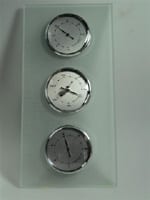
B for barometer is a measuring device for measuring air pressure. Thermometers, butyrometers (fat gauges) and other glass measuring instruments that are still made in Wertheim today are among the first products of the glassblowers who settled in Wertheim after the Second World War (1938-45): the thermometer glassblowers.
B - Bohemian glass
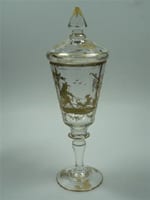
B for Bohemian glass of high purity and light refraction, with or without coloured overlay, was the preferred glass in the Baroque, Rococo and Biedermeier periods (c. 1685 - 1850) due to its brilliance and ornate cut and section motifs.

Drinking glasses with baluster stems, goblets, ranft cups, intermediate gold and gold ruby glasses were particularly popular.
B - Beryl > Glasses
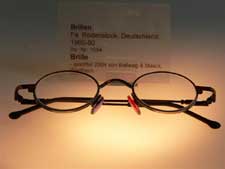
B for glasses and beryl: In the 13th century, it was very difficult to produce colourless, completely transparent glass. Therefore, the monks used the rock crystal or semi-precious stone "beryl" to make their reading stones, the first visual aids.
The word "spectacles" was later derived from "beryl".